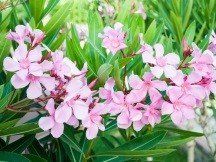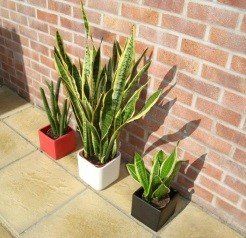Plant Toxicity in Pets
HVH • 17 December 2019
Now that the sun is out and our plants are flowering, you may notice your pets outside exploring their environment. Our pets can be very adventurous so we need to be aware of any dangerous plants that might be around our home and in our gardens.
If you are getting a new furry friend for Christmas, make sure you provide them with a safe and secure environment.
Here are some plants that can potentially be toxic if your pet decides to start chewing on them:
If you think your pet may have been eating any of these plants, please contact us for advice.
This Facebook widget is no longer supported.

Meet Percy the Cocker Spaniel and his mum Emma. Percy presented to HVH in January suffering from respiratory distress. This had been going on for over six months. During this time Emma (Percy’s mum) had been doing a wonderful job managing his condition at home with medication and monitoring of his breathing. A few months later Percy was presented back to HVH with difficulty breathing. We scheduled Percy in with Dr. Debbie to have his throat examined under a general anaesthetic. During this examination, Dr Debbie diagnosed Percy with Laryngeal Paralysis. This means his larynx was not opening properly to allow enough air in when he was breathing, especially when panting. This is the video of Percy’s throat.

Desexing or neutering your pet is a surgical procedure that prevents them from being able to reproduce. In male pets it is commonly referred to as “castration”, and in female pets as “speying”. This is the most frequent surgery performed by our vets, and generally your pet is home the same evening after surgery. The most common age to desex your pet is between 4 and 6 months, however they are never too old to be desexed. There are many benefits to desexing your pet before 6 months. They include: Preventing unwanted litters, which can be very costly, and may add to the already overwhelming number of stray animals that are put down each year. Prevention of testicular cancer and prostate disease in males, and it can help prevent pyometra (infection of the uterus) and mammary tumours (breast cancer) in females. Stopping the “heat” cycle in females. Decreasing aggression towards humans and other animals, especially in males. Being less prone to wander, especially in males. Living a longer and healthier life. Reduction of council registration fees. For further information on desexing your pet please contact one of our team at the clinic.

Owning a dog provides companionship, loyalty and affection for people of all ages and is an invaluable addition to families and individuals. However, it is important to find the breed of dog most suitable to your particular lifestyle and be aware of the responsibility that comes with dog ownership before you adopt or purchase a dog. As your vet, we are willing to discuss the many aspects of dog care, including breed-specific medical problems and routine health care such as vaccinations, flea and tick control, desexing and worming that your future dog may need. Before and after purchasing your puppy or dog, there are several important aspects of their care, to consider: We strongly recommend that you consider pet insurance for your new dog. Please see our section on pet insurance for more about this topic. Suitable bedding such as washable rugs, cushions or blankets need to be provided in a weatherproof kennel or indoors. A secure area such as a dog-proof yard is essential. Your dog should never be left unsupervised when tethered. All dogs need daily exercise and mental stimulation to help avoid behavioural and health problems. Dogs are social creatures and can develop behavioural issues if they feel neglected or excluded. It is also vitally important that dogs are socialised with people and other dogs from an early age in order to learn appropriate interactive behaviours. We recommend two health checks per year but an absolute minimum is one health check per year. On average, dogs age five to eight times faster than humans, allowing major health changes to develop in a relatively short amount of time. The risk of cancer, diabetes, obesity, arthritis, heart disease and other serious conditions all increase with age. However, a visit to us helps us diagnose, treat or even prevent health problems before they become life-threatening. Routine vaccinations, flea and tick control and worming are also recommended. This is also a good opportunity to ask about nutrition, behaviour, and other issues. Nutrition is an important part of your dog’s care. A healthy and balanced diet is essential. This will provide protein to build the body; fats for skin and coat health; carbohydrates for energy; and minerals and vitamins for good bone development and healthy tissues. We recommend a premium quality dog food supplemented with fresh water. It is essential to keep your dog’s teeth clean. A regular dental care routine will minimise tartar build-up on your pet’s teeth. Never give your dog cooked bones, as these can be brittle and easily splinter, causing harm to your dog. Raw bones with meat and sinew attached can be helpful for keeping teeth clean but brushing and special dental diets are often more effective. Fresh water bowls must always be available for your dog. They should be kept clean and placed in the shade. Grooming and brushing is essential, particularly for long-haired breeds. This helps remove dust, dead skin, loose hairs, grass seeds, and tangles and it also assists to shorten the coat moult, which occurs every autumn and spring. Dirty or smelly dogs should be bathed. However, keep in mind that frequent shampooing can strip the natural oils from the coat and cause skin dryness and irritation. Our staff are always keen to discuss routine health care for your current or future pets. For further information about pet care, please phone our helpful staff during business hours.

Cats can make excellent companions and are wonderful pets. However, with an average lifespan ranging from 15-20 years, owning a cat is a long-term commitment and their needs must be carefully considered. Before you bring your cat or kitten home, we suggest you contact your local council and enquire about its regulations regarding such things as night curfews, compulsory containment within a property, desexing and microchipping . A cat’s housing needs are simple. Whilst they will usually find a corner that suits them best indoors or outdoors, provide them with a basket, box or chair in a place where they feel safe and protected. Increasingly, people are using cat enclosures for outdoor cats. Placed in a weatherproof area, they keep them safe from neighbourhood cats and protect local wildlife. Indoor cats generally live longer and lead healthier lives provided they are given adequate play and mental stimulation. It is recommended a scratching post be available for your cat to keep their claws in good condition for climbing and defending themselves. This will also reduce the chances of your furniture being scratched. Cats like to be clean at all times. As a result, cats can easily be toilet trained if a litter tray filled with dry earth, sand, or cat litter is available. The litter tray should be cleaned daily to remove faeces and the litter itself changed frequently. Ensure the litter tray is placed in a quiet and private location. You may even need multiple trays if you have more than one pet cat. A good rule of thumb is one tray for each cat plus one extra. The trays need to be in different locations throughout the house, rather than lined up together. All cats need to exercise. As cats naturally like climbing and perching themselves up high, trees and fences, for example, provide good opportunities for them if they have outdoor access. Indoor cats, however, will use furniture to climb and perch. Once again, having a scratch pole or indoor cat gym will give an indoor cat an effective alternative. Providing higher perching locations will also give your cats a more enriched environment. Most cats require grooming assistance from their owners to remove excess hair. This helps in the reduction of furballs/hairballs and matted/tangled fur, which if left, may result in a visit to us. Except at moulting time, short haired cats are able to groom themselves adequately. In contrast, long haired cats require daily grooming by their owners. Furballs or hairballs can cause appetite and weight loss, and in a worst case scenario, result in surgery. During the moulting season daily brushing is essential and food designed specifically to assist with the reduction of hairballs will also help your cat process consumed hair. Unlike dogs, you should not need to bathe a cat. Most cats are grazers, so we recommend feeding small amounts often. They require a high protein and fat diet. There are many formulations of cat food available and we recommend discussing your cat’s individual nutritional needs with us to choose the most suitable formula. Raw chicken wings/necks are excellent in maintaining good dental health. Ensure a fresh water bowl is accessible at all times, especially if they have a dry food diet. Whilst many cats love to drink cow's milk, it's not recommended as they can be lactose intolerant and experience stomach upsets. We recommend two health checks per year but a minimum is one health check per year. Regular visits help us diagnose, treat or even prevent health problems before they become life-threatening. Routine vaccinations, worming and flea control form the basics of feline medical care. We can also provide additional guidance on nutrition, behaviour, training and life-stage treatments available. We welcome you to book an appointment with us to discuss how to keep your cat in optimum mental and physical health.

There are a huge variety of birds available as pets in Australia. Each variety has unique characteristics, colours, sizes, temperament and special needs so it’s important that you learn and gather as much information as possible. This will help you choose the right bird for your needs and also cater adequately for the bird’s needs too. Some birds like handling but others don’t. All birds are enjoyable to watch, listen to and have around. Some birds are great talkers, others have a beautiful song and some bring endless fun antics to each day. Learn all you can about the type of bird you are getting. Equipped with knowledge and understanding, you will have a better idea of what to expect. You'll then be able to provide the pet bird care it needs and the result will be maximum enjoyment. Buying a bird is a serious commitment for at least five years but some birds can even live as long as you! Keep in mind the following helpful checklist when making your decision: Children caring for birds: Owning a pet bird provides a child with companionship and teaches the child responsibility and care. Parents must still supervise the day-to-day care so that the bird is not neglected through ignorance or loss of interest. Which bird? A canary or budgerigar is a particularly good pet for a family with very limited space or modest means. They are suitable for people living alone, especially flat dwellers. The care of these caged birds could hardly be more simple or undemanding, but the individuality they show depends on the degree of freedom they are allowed and on the stimulation provided by their surroundings and their companions. Male or female: Only the male canary sings and whistles, and the male budgerigar is usually easier to teach to talk. There are important differences to be aware of between the genders of each species. Health care routine: Please ask one of our vets regarding a good health care routine. Housing: A well-designed and built aviary is the most satisfactory housing for birds, enabling them to live with freedom of movement and adequate opportunity for flight. Circumstances often dictate that birds are kept in cages, usually manufactured of metal with wire mesh screening. The minimum size of cage to house one bird will depend on the breed of bird. The cage should be positioned in a well-lit, sunny area where the birds will have frequent human contact, and in which it will be safe to be released for exercise if possible. A portable cage stand permits the birds to be repositioned for their comfort. Appropriate perches of varying size must be provided as well as well-secured food and water troughs. The food and water receptacles should not be positioned beneath bird perches and any accidental contamination of the food and water by bird droppings must be removed immediately. Activities: Ladders, bells, ropes, swings, mirrors, and suitable toys provide some stimulation for a caged bird, but avoid over-furnishing as this will crowd the cage and may result in injury. Changing toys regularly will increase the stimulation provided by each toy. Protection: At night the cage should be covered over to permit the bird to rest and to protect it from draughts. Should the cage be placed outside the house at any time, it must be in a position that is safe from predators - cats and wild birds – that could scare or directly injure the bird. Birds should not be left in the sun without shade and should be protected from overheating on hot days. Cleaning: A tray on the floor of the cage will collect excreta and should be removed each day and thoroughly cleaned. The cage itself should be easy to scrub out, while water and food troughs and perches should be easily removable for cleaning purposes. Handling: It is important to train your bird to be handled, especially to permit examination for signs of ill-health. Begin by letting them become accustomed to being handled in the cage. Soon they will become finger-tame, and then they may be able to be handled outside the cage. It will require a good deal of patience and gentleness when handling birds, especially canaries. Talking: Some birds that have constant close contact with their owner will learn to talk. These birds can start to talk at about six weeks of age, and if they have not succeeded by six months, they probably never will. Teaching a bird to talk starts by using the same word over and over. Once the bird has learnt one word, new words or complete phrases may be achieved. Feeding: The caged bird's basic diet should consist of the specially prepared pellet mixtures. This diet should be supplemented with green foods, seed and fruit. Cuttlefish bone should be available in every cage to provide many trace minerals required by birds. Fresh water is essential to a bird’s life and must be replenished frequently in hot weather or if it becomes fouled.

Rabbits are great pets that have character, are extremely sociable, enjoy the company of humans and are a great way of introducing young children to pet ownership. They are quiet, clean and are easily toilet trained. While rabbits love company, they can be left alone during the day and are therefore suitable for people who work or are away from home. A predator-proof enclosure to ensure their safety is essential. An appropriate enclosure is a hutch that is divided into two connecting compartments, one a wire mesh to allow access to natural light and fresh air, while the other is enclosed to provide protection against weather and a secure sleeping place. The floor of your rabbit's hutch should be covered with newspaper, with a layer of bedding material like straw, grass, hay or shredded paper for warmth, comfort and to prevent pressure sores on your bunny’s feet. Consider extreme weather conditions and ventilation when choosing a location for your hutch. Rabbits are extremely sensitive to the hot summer temperatures we experience in Australia and may die of heat stroke if their hutch is not in a cool, shady position. Rabbits should have at least two hours outside of the hutch for exercising each day. Handling them will also be of benefit in keeping them tame. Using a firm brush to remove dead hairs, tangles and pieces of garden matter should form part of your daily routine. Grass seeds can commonly become stuck in their eyes, ears and nose, causing irritation or even infection. Check your rabbit’s rear end daily to make sure it is clean and dry, if soiled it is very prone to fly strike. Feeding and nutrition is the most important factor in making sure your rabbit stays healthy. Many commercial rabbit foods don't contain enough fibre (18 - 20% is required) and are too high in fats and sugars. Rabbits are herbivores so their diet should consist almost entirely of vegetable matter. Pellets and mixes should not form a main part of the diet. Grass or hay is an essential dietary component to ensure your rabbit’s health. Apart from providing a high fibre diet, chewing hay wears down their continuously-growing teeth and keeps them occupied, preventing boredom. Ideally, feed your bunny 85% hay and 15% veggies such as Asian greens or endive (lettuce and cabbage can cause diarrhea). Treats such as fruits, root veggies (carrots), capsicum and pellets should only be offered in small amounts (1 - 2 tablespoons per day per rabbit). Fresh water should always be available using both a drip feed bottle and an open container. Routine veterinary care for rabbits includes vaccination against calicivirus and desexing (females can become quite aggressive when mature and are very prone to reproductive cancers). Like all animals, rabbits should have regular veterinary checks, especially to check their teeth and claws. We welcome you to book an appointment with us to discuss how to keep your rabbit in optimal health.

Most native reptiles are protected by Law which means they cannot be kept as pets. Usually only zoos and fauna parks are given permits to hold these animals. Non-native reptiles are even more stringently controlled by Law as they pose significant risk to Australian ecosystems. A permit is required from DELWP to keep many reptiles. If you’ve found or rescued a reptile, tortoise, lizard, crocodile, snake or frog, it’s best to immediately arrange with Wildlife Victoria for the animal to be released back into the wild.

























